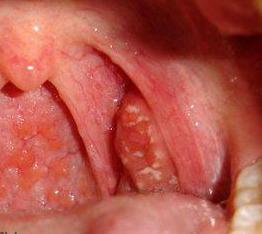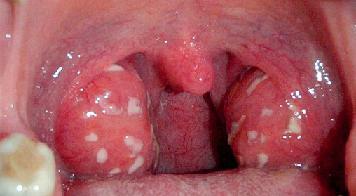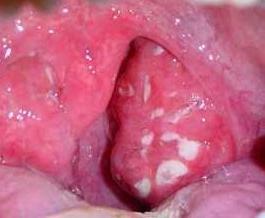 Follicular angina is an infectious disease that manifests itself in the form of inflammation of the palatine tonsils. In adults, angina can be caused by different types of microbes and is transported by airborne droplets or by contact with dirty dishes or unwashed products.
Follicular angina is an infectious disease that manifests itself in the form of inflammation of the palatine tonsils. In adults, angina can be caused by different types of microbes and is transported by airborne droplets or by contact with dirty dishes or unwashed products.
The causative agent of this form of angina is most often streptococci and staphylococci. The disease occurs with weakened immunity, general or partial hypothermia of the body.
One of the most common varieties is the follicular form of angina, the treatment and symptoms of which we will consider today.
Causes of
Why does the follicular sore throat appear, and what is it? It arises as a result of infection of the tonsils with bacteria that enter the body exogenously( externally) or endogenously( the degeneration of their opportunistic flora occurs).The main reason for the appearance of this disease is an infection called staphylococcus.
The onset of follicular sore throat occurs in the following cases:
- getting into the amygdala of streptococci and staphylococci;
- the presence of microbes that develop during the cold season;
- significant hypothermia of the throat, which led to a general decrease in the immune defenses of the body;
- viruses of diphtheria, syphilis, pneumonia and others, which lead to inflammatory processes in the tonsils.
A weakened immune system can no longer restrain opportunistic microorganisms, and they begin to multiply intensively in the oral cavity, causing inflammation of the tonsils.
Remember that follicular angina is highly contagious, with a severe course of the patient remains in the hospital. At home, the patient should be in a separate room, use only personal items, limit contacts.
What happens to the tonsils?
In follicular angina inflammation is localized in the follicles of the tonsils, in which pus appears, translucent through the mucous membranes of yellow-white foci. As the well-known doctor Simanovsky said, the picture of tonsils with follicular angina is very similar to the starry sky.
Over time, these purulent foci can merge with each other, forming one continuous purulent coating of yellow-white on the tonsils. The abscesses can melt tissues and break into the pharynx.
Symptoms of follicular sore throat
 Purulent follicular angina has certain symptoms that appear after the incubation period - usually, it lasts no more than a day. In contrast to catarrhal angina, purulent processes cause a more severe course of the disease.
Purulent follicular angina has certain symptoms that appear after the incubation period - usually, it lasts no more than a day. In contrast to catarrhal angina, purulent processes cause a more severe course of the disease.
Symptoms of angina start acutely:
- appears chills;
- temperature rises to 39-40 degrees;
- strong weakness, a feeling of aches in the lower back and joints;
- you feel a loss of appetite;
- lymph nodes are enlarged and painful on palpation;
- palatine tonsils and fate around them swell, inflame and blush;
- observed festering follicles - white or yellow plaques on the tonsils;
- because of very strong and acute pain the patient is difficult to swallow;
- with a strong rhinitis is difficult to breathe with your mouth and nose.
When examining the throat is clearly visible swelling, puffiness and severe reddening of the glands( more often - palatine).The surface of the soft palate and tonsils is covered with a scattering of white and yellow dots of round shape( reminiscent of millet grains), which are festering follicles.
Because this sore throat is often combined with lacunar, the surface of the tonsils can be covered with a white coating, and abscesses form in the mouth of the lacunae.
Follicular angina in children
The disease begins with a feeling of severe malaise. A child can complain first of all of a sore throat and a worsening of well-being. Among the most popular symptoms, which also bring the most unpleasant sensations, are headache, aches in joints, nausea to vomiting, inability to swallow food. All this occurs against a background of profuse fever and chills, which last about 2 hours, and then are replaced by a state of improvement. The body temperature rises sharply to high figures.
This condition in a sick child lasts about 2 days, when the peak is reached during the disease. This symptomatology is accompanied by edema of the pharynx and neck, rashes, cough and rhinitis, conjunctivitis, pain in the area of the stomach, enlarged lymph nodes. A great difficulty for the child is breathing and swallowing.
Follicular sore throat: photo
How this particular ailment looks like, we offer detailed photos of

Complications of
Follicular sore throat looks unattractive in the photo, but this is not its most unpleasant property. It is fraught with serious complications from the cardiovascular system, kidney and urinary system as a whole, the destruction of joints. Can go into a chronic form and weaken the immune system.
That is why it is so important to recognize follicular sore throat in the early stages, to differentiate it from other similar diseases, to start treatment and to finish it with the observance of bed rest and the necessary hygienic recommendations.
Treatment of follicular sore throat in adults
 For the purpose of effective treatment, a smear from the tonsils is taken, which is then examined by laboratory methods to determine the causative agent of the angina and its sensitivity to antibiotics.
For the purpose of effective treatment, a smear from the tonsils is taken, which is then examined by laboratory methods to determine the causative agent of the angina and its sensitivity to antibiotics.
In most cases purulent acute tonsillitis is caused mainly by beta-hemolytic streptococcus of group A, sensitive to penicillins, cephalosporin series of antibiotics, carbapenems.
At home, you must follow certain rules, which in the case of follicular sore throat will help cure it faster.
- Adult or child should limit activity and how can spend more time alone , better in bed. Violation of bed rest and, even more so, fulfillment of tedious duties can sharply worsen a patient's condition and aggravate the severity of the course of the disease.
- The second prerequisite is the abundant drinking warm drink .It is advisable for the time of illness and a few to change the patient's menu. Food should be mashed, soft. Thanks to this and so the inflamed larynx will not be irritated, and to swallow such food is much easier. Recommended dietary table number 13.
- It is better for the aching person to allocate a separate room of , often to air it and to carry out wet cleaning. Dishes, linens and towels should also be separate and after use boiled or sprinkled with boiling water. Limit contact with the sick, especially not to let the children - they are particularly susceptible.
- Also the most important condition for the correct treatment of follicular sore throat at home is frequent rinsing of the throat. Use in the procedure can be special antiseptic agents such as Iodinol, Dolphin, Lugol, Chlorophyllipt, Miramistin, furacilin( 2 tablets per glass of water), herbal infusions, soda and salt solution.
- Antibiotic therapy. To eliminate streptococcus, the most common cause is prescribed protected penicillins( augmentin, amoksiklav).With intolerance of the penicillin group - other groups of antibiotics: macrolides( azithromycin), cephalosporins 1-2 generations( cefotaxime, cefuraksim).Dosage is individually prescribed by the attending physician according to age and severity of the course.
- Anti-inflammatory and analgesic sprays help to reduce irritation of , relieve pain and facilitate swallowing. These drugs include Ingalipt, Cameton, Tantum Verde. You can use a variety of lozenges for resorption.
If you have a follicular sore throat, the treatment of which was started untimely, and if the antibiotic in the sore throat is incorrectly selected and if the patient's immunity is severely weakened, serious consequences may appear.
Antibiotics
Treatment of follicular sore throat with antibiotics should be carried out with strict adherence to individual doses, in accordance with the severity of the disease and the age of the patient.
The antibiotics of penicillin group, such as "Bicillin", "Amoxicillin", "Benzylpenicillin" are most often prescribed. If the patient is allergic to penicillins, antibiotics can be prescribed from the group of macrolides( Clarithromycin, Erythromycin, Sumamed, Azithromycin) or cephalosporins( Cefazolin, Cefalexin).
Remember that even if your condition has improved, in no case should you stop using the antibiotic , because with an incomplete course of taking an antimicrobial drug, the pathogen develops resistance to this type of antibiotic, and the disease begins again, but in a more severeform, and the previous drug will not help.
Also mandatory for the course of antibiotics is important to use drugs that prevent the development of dysbiosis. They include Lineks, Bifidumbacterin, etc.

How to choose probiotics for the intestines: a list of drugs.

Effective and inexpensive cough syrups for children and adults.

Modern non-steroidal anti-inflammatory drugs.

Review of tablets from the increased pressure of the new generation.
 Antiviral drugs are inexpensive and effective.
Antiviral drugs are inexpensive and effective.



